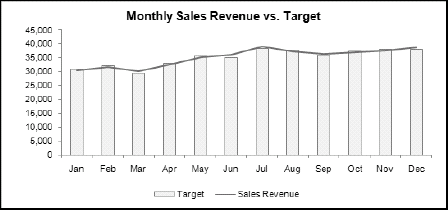Chapter 9. Components That Display Performance against a Target
Hopefully, this is an easy one to grasp. Someone sets a target, and someone else tries to reach that target. The target could be anything from a certain amount of revenue to a number of boxes shipped or to phone calls made. The business world is full of targets and goals. Your job is to find effective ways to represent performance against those targets.
What do I mean by "performance against a target"? Imagine your goal is to break the land speed record, which is currently 763 miles per hour. That makes your target 764 miles per hour, which will break the record. After you jump into your car and go as fast as you can, you will have a final speed of some number. That number is your performance against the target.
In this chapter, I explore some new and interesting ways to create components that show performance against a target.
Showing Performance with Variances
The standard way of displaying performance against a target is to plot the target and then plot the performance. This is usually done with a line chart or a combination chart, such as the one shown in Figure 9-1.

Figure 9-1. A typical chart showing performance against a target.
Although this chart allows you to visually pick the points where performance exceeded or fell below targets, it gives you a rather one-dimensional view and provides minimal information. Even ...
Get Excel® 2007 Dashboards & Reports For Dummies® now with the O’Reilly learning platform.
O’Reilly members experience books, live events, courses curated by job role, and more from O’Reilly and nearly 200 top publishers.

